

Would you like to receive publication updates from HLT? You can by joining the free mailing list today. |
Humanising Language Teaching
Year 5; Issue 1; January 03
The NLP Spelling Strategy
primary, secondary and adultRuth Hamilton, UAE, The Arabian-Iranian Gulf
If this article interests you, Pilgrims offers courses in this area. Click here for more information.
“Excellent!” “Well done!” When was the last time someone said these words to you? Think back to that time now. Close your eyes and recall an image of that moment, look at the person and listen to their voice as they say those words to you again, and feel that wonderful feeling of receiving praise for your work, exactly as you felt it then. Now grab hold of that feeling and bring it back with you to the present, and open your eyes. How does that feel?
Introduction
This article reports a spelling project I carried out this year with a group of Emirati male students at the College where I work, the aim of which was 'to help students improve their spelling by using the NLP spelling strategy.'
NLP : Modelling Excellence
“NLP is the art and science of excellence, derived from studying how top people in different fields obtain their outstanding results.” (O'Connor & Seymour, 1995: xii) By observing the strategies used by people who do things well and replicating or 'modelling' their behaviour, we can improve our skills in all areas of life: communication, business, education, law, sport or therapy. Modelling excellent behaviour leads to excellence is one of the presuppositions or principles of NLP.
Excellent spellers nearly always go through the same strategy - they look up or straight ahead as they spell, visualizing the word as they spell it. This is because spelling is a visual process – we need to visualize, or see a word we've seen before in order to spell it. If you observe good spellers at work, you will see their eyes moving up to the left, to access their visual memory, then move down to feel if it's right or write it down, accessing their kinesthetic channel, then look up again to check it looks right.
For visual learners this is easy and good spellers will do it automatically. However, those with other dominant learning styles will have problems. Learners with a preferred auditory learning style will try to spell from the sound of the word – watch their eyes moving to the left as they listen to the word, probably saying it to themselves at the same time! This is not very effective when it comes to English spelling due to the relative complexity of English sound/spelling relationships. As Blackerby (2001:3) points out: “In the English language all words do not look like they sound. Therefore, all words cannot be correctly spelled according to how they sound but they can be spelled correctly according to how they look.” Those with a preferred kinesthetic learning style will look down, saying the word to themselves or searching their feelings, or maybe feeling bad because they can't spell it … because they can't see it! Anyone who looks up to the right, is creating a new word spelling they haven't seen before, as they are accessing 'visual construction' rather than 'visual memory', so their spelling may be very creative, but probably incorrect!
Eye-accessing Cues (as you look at another person) :
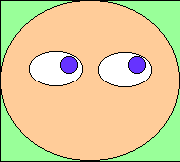
Visual: remembered images
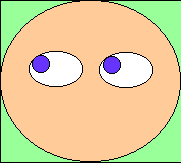
Visual: constructed images
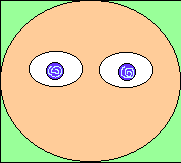
Visualising
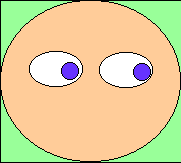
Auditory : remembered sounds
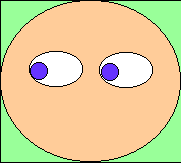
Auditory: constructed sounds
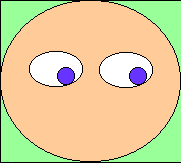
Internal dialogue
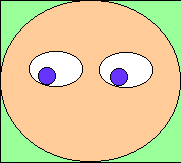
Kinesthetic
(feelings & bodily sensations)
Note: These eye movement patterns typically apply to the majority of right-handed people. Left-handed people may show the reverse of all these movements.
Looking down makes it difficult to visualize and so makes it more difficult to spell for those who do not naturally use their visual channel, so when we give our students a traditional dictation, we may in fact be hindering rather than helping them, by encouraging them to use their auditory channel ('listen to this') and kinesthetic channel ('write it down') to spell, rather than their visual channel, which is what they need to spell correctly.
The NLP Spelling Strategy : Procedure
- Hold a card with the word on it up high and to your left in the visual accessing area. (tip: write new words up in this position on the board).
- Look at the word and spell it – forwards and backwards (this makes sure the image is clear as it is only possible if you can 'see' it).
- Take the word away and form a mental image of the word – look at the smaller chunks of the word, add colour, add or change the background colour, change the size or font. Look at the word until the image is clear. It is important to see this image of the word, rather than just look at it.
- Look at the image and write down what you see. Look up and check that it is correct. If not, go back to Step 1, take another look at the word and get the image clear in your mind.
Students can make their mental image clearer by changing its submodalities, for example by making it bigger or brighter, even into a flashing neon light, bringing the image closer, changing the size or colour of smaller chunks of the word, such as prefixes or suffixes, giving a texture to the words, or blinking eyes to take a mental photograph of the word, tracing the spelling in the air or even saving it in a folder on an internal computer screen, which can be operated with an imaginary mouse. For learners with a predominantly kinesthetic learning style, these 'motor' aids can help reinforce their visual memory with movement. Those with a predominantly auditory style may like to say the word aloud, add sounds to words or group words according to their number of syllables or rhyming sounds.
This spelling strategy has been tested on different groups of people, with success, including children who have been labelled as dyslexic. As O'Connor & Seymour (1995:194) advocate: “Often these children simply are more auditory or kinesthetic than other children.” They have a point when they state: “Wun wunders why foenick spelling methods arr stil tort in skools.”
The spelling strategy is a learning strategy at the capability level, which is why it works better than, say, learning lists of words by rote. Rote learning may help you spell those words in order to pass a test, but does not make you a good speller, or build capability.
By training students to use their visual channel in order to spell well, we can help them not only to improve their spelling, but also to provide them with a new or stronger learning channel to help broaden their learning strategies in general. A lot of students have ineffective learning strategies, because they have not learned how to learn and therefore come up with their own strategies, which may or may not be effective. Without alternative or effective strategies they can become stuck. “If you always do what you've always done, you'll always get what you always got. And there is always more.” (O'Connor, 2001:46)
The Spelling Project
The Students:
Arab students tend to be predominantly auditory and kinesthetic learners and often have difficulty visualizing. This is probably one of the reasons, or certainly contributes to the fact, that many of them are poor spellers. Their strengths in English are generally speaking and listening, which are mainly auditory skills; their weaknesses are reading and writing, mainly visual skills. Culture and previous learning experience have a strong influence on their preferred learning styles and strategies. Passing down stories and history from one generation to another by word of mouth is a deep-rooted tradition in a country where no written records of events were kept and school education did not exist until the 1960s. This helps to explain their great love of talking, but lesser interest in reading. Their classroom behaviour reflects these preferences: the students love talking and moving around. When reading, they prefer to read the text out loud or to themselves, often following the line with their finger as they read, and find it hard to sit still. They will even take a stroll across the classroom at times to talk to a friend or shake their hand! In school there is a lot of rote learning and reciting. As their own language uses a different script and is phonetic, students have added difficulties with writing and spelling.
I carried out the spelling project with a group of seven students, at lower intermediate level (studying for PET), over a period of 5 months.
Procedure: ·
- The students first selected three words from their own written work and wrote these words on card. (Different coloured pens or card can be used for different word forms, e.g. blue for nouns, green for verbs, red for adjectives, and so on.) ·
- The strategy was demonstrated with these words as described above and the students practised in pairs. ·
- The students practised regularly in class and were encouraged to do so outside the class. ·
- More words were gradually added to their bank, then pooled by the group (we built up to a 40 word bank in one semester, then a new 40 word bank in the next semester) ·
- The students were given regular spelling tests, consisting of 10 or 20 sentences containing the target words. The sentences were dictated and when students reached the target words, they applied the technique: 'stop, look up, see and spell, write, look up to check'. After writing each sentence, they checked the target words once more. Only these target words were corrected, but other misspelt words were later included in the students' word banks. ·
- As the students worked with their word banks, both individually and with others in the class, they separated words spelt correctly into one pile and those needing further practice into another pile and continued working on the latter outside the classroom. ·
- The same test was given again, about ten days later, and the results of the two tests compared. ·
- Regular tests were given throughout the semester, every 2 or 3 weeks, using different sentences. ·
- Every month the students were given a piece of writing. These were kept and the number of spelling mistakes in each text compared, especially the first and last writing tasks of the course. ·
- Throughout the year, the students collected misspelt words from their written work to add to their personal word banks.
Feedback and Conclusions:
Feedback on the project was obtained from the following sources:
- Regular dictations to test spelling
- The number of spelling mistakes in the students' written work over the course
- Students' feedback questionnaires and discussion
- Teachers' observations and feedback
It is quite difficult to draw conclusions from the results of spelling tests and written work, as there are many other factors at work when students do these, such as time of day, topic, level of concentration or emotional state. However, on the whole, the students studied for the tests and did well in them. There were definitely fewer mistakes in most of the students' written work at the end of the course as compared with their first piece of writing. I noticed that the number of other spelling mistakes made in the dictation sentences, i.e. not the target words, decreased over the course and were much lower in the final test than the first. Many of the students scored 100% in the final test and one student made only one other spelling mistake in the forty sentences dictated.
Only one student in the group seemed to resist the technique and did not follow the strategy when spelling, even when encouraged. In fact his spelling and written work actually deteriorated over the course. Before we commenced the project he was one of the strongest in the class in writing and he made fewer spelling mistakes at the beginning of the course than at the end. As the course drew to an end, he appeared to make less effort and take less pride in his work than at the start of the course. No conclusions can be drawn here connecting his performance with his resistance to the strategy, without looking deeper into the possible causes of his change in attitude, which may have been due to the fact that he had been one of the strongest students at the beginning of the course, or due to personal or family problems. However, he preferred not to discuss this change.
To sum up, it appears that when the students studied and applied the technique, they did well, and this was reflected in the spelling test results.
In the students' feedback it was clear that they all found the technique useful, and believed that it helped them with their English - which alone is a good enough reason to do it. They all felt their spelling had improved, they'd enjoyed doing it, and some had passed the technique on to friends or family. They all thought it was a good idea to get other classes to do it and most were willing to go and visit other classes to introduce the technique. Those who were not keen to do this admitted that this was due to shyness. All said they would continue using it after the course and would also be interested in trying out other techniques in the future to help them with their learning.
Three other teachers in the college also did the project this year and had similar results with their classes. What worked particularly well was getting a student from my original group to visit the other classes to explain the project and answer questions about it. The other students were interested and motivated to start the project too and it was also good for the visiting student's confidence. The success of the project also proved to be a useful empowering tool, giving more confidence to some students who are normally shy and hesitant.
Questions raised / Action Plan:
- It is possible that those students who did very well were in fact more visual than others in the first place, so before starting the project with other groups, it would be useful to find out the students' preferred learning styles beforehand, by devising a learning style questionnaire for students to complete and observing students behaviour and spelling strategies.
- There may be a number of reasons for students not performing well or not succeeding in using the strategy successfully and students' attitude to the project may affect their performance. In future, it may be possible to draw clearer conclusions about the students' performance by monitoring them more closely and encouraging them to be more open to discussing their feelings, as well as getting more frequent feedback during the project.
- The project was carried out with four classes only. This needs to be extended to include more groups, and a greater variety of groups, in order to determine whether the type of class, in terms of level, size, gender, age, reasons for studying, profession or time of class makes a difference to the overall results.
Next year, the teachers involved will also be continuing the project with more groups of students and building up a resource bank of activities and materials to help the students improve their spelling, as well as to strengthen their visualization skills, as in our students' case, this is the weakest learning channel.
Conclusion : Developing students' learning strategies
If you decide to use this strategy to help your students improve their spelling, I suggest first finding out what your students' preferred learning styles are. Ask them to spell words and observe their eye movements; use learning style questionnaires to focus on their behaviour and preferences. By determining students' dominant learning styles, we can exploit these preferences, but also strengthen other weaker or less-used channels, in order to make their learning more effective.
A study carried out by J.W. Logan and others (Vos Savant, 2000:42) discovered that “most (champion spellers) used three main spelling strategies: visual memory, writing or saying words aloud, and regular use of the dictionary.” These strategies combine the three main sensory channels: visual, auditory and kinesthetic, and so make for more effective learning. The more channels open, the more successful learning will be. Two additional factors which have been found in good spellers, and also found to be key factors in promoting the visual perception of word form, are good handwriting and good proofreading skills, which can also be worked on and practised in class. For students, such as Arab students, who are not predominantly visual learners, this can help them strengthen their visual skills.
NLP techniques enable us to understand our inner learning processes and help us manage our own internal software: images, sounds and feelings. By using such techniques, we can motivate and empower our students by teaching them how to learn as well as what to learn.
Bibliography:
Andrea, S. & C, Heart of the Mind, Real People Press, 1989
Blackerby, D.A., NLP in Education – A Magnificent Opportunity, www.positivehealth.com/permit/Articles/NLP/black39.htm, 2001
Grinder, M., Righting the Educational Conveyor Belt, Metamorphous Press, 1991
O'Connor, J., The NLP Workbook, HarperCollins, 2001
O'Connor, J. & Seymour, J., Introducing NLP, Thorsons, 1995
Revell, J. & Norman, S., In Your Hands, Saffire Press, 1997
Vos Savant, Marilyn, The Art of Spelling, The Method and the Madness, WW. Norton & Co., NY, 2000